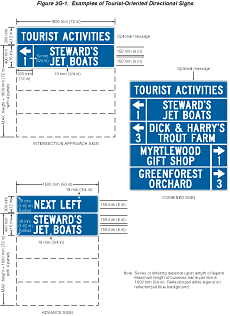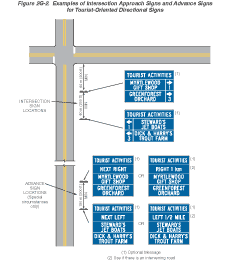Chapter 2G. Tourist-Oriented Directional Signs
Section 2G.01 Purpose and Application
Support:
Tourist-oriented directional signs are guide signs with one or more
panels that display the business identification of and directional
information for business, service, and activity facilities.
Standard:
A facility shall be eligible for tourist-oriented directional signs
only if it derives its major portion of income or visitors during
the normal business season from road users not residing in the area
of the facility.
Option:
Tourist-oriented directional signs may include businesses involved
with seasonal agricultural products.
Standard:
When used, tourist-oriented directional signs shall be used only
on rural conventional roads and shall not be used on conventional
roads in urban areas nor at interchanges on freeways or expressways.
Where both tourist-oriented directional signs and Specific Service signs (see Chapter 2F) would be needed at the same intersection, the tourist-oriented directional signs shall incorporate the needed information from, and be used in place of, the Specific Service signs.
Guidance:
Each State that elects to use tourist-oriented directional signs
should have a State policy for use as indicated in Section
2G.07.
Option:
Tourist-oriented directional signs may be used in conjunction with
General Service signs (see Section
2D.45).
Section 2G.02 Design
Standard:
Tourist-oriented directional signs shall have one or more panels
for the purpose of displaying the business identification of and
directional information for eligible facilities. Each panel shall
be rectangular in shape and shall have a white legend and border
on a blue background.
The content of the legend on each panel shall be limited to the business identification and directional information for not more than one eligible business, service, or activity facility. The legends shall not include promotional advertising.
Guidance:
Each panel should have a maximum of two lines of legend including
not more than one symbol, a separate directional arrow, and the
distance to the facility shown beneath the arrow. Arrows pointing
to the left or up should be at the extreme left of the sign. Arrows
pointing to the right should be at the extreme right of the sign.
Symbols, when used, should be to the left of the word legend or
logo.
Option:
The tourist-oriented directional sign may have the word message
TOURIST ACTIVITIES at the top of the sign.
Standard:
The TOURIST ACTIVITIES word message shall be a white legend and
border on a blue background. If used, it shall be placed above and
in addition to the panels.
Option:
The General Service sign symbols (see Section 2D.45) and the symbols
for recreational and cultural interest area signs (see Chapter 2H)
may be used.
Logos for specific businesses, services, and activities may also be used. Based on engineering judgment, the hours of operation may be added on the panels.
Standard:
When used, symbols and logos shall be an appropriate size (see Section
2G.04). Logos resembling official traffic control devices shall
not be permitted.
Support:
Examples of tourist-oriented directional signs are shown in Figure
2G-1 and 2G-2.
Figure 2G-1 Examples of Tourist-Oriented Directional Signs

Figure 2G-2 Examples of Intersection Approach Signs and Advance Signs for Tourist-Oriented Directional Signs

Section 2G.03 Style and Size of Lettering
Guidance:
All letters and numbers on tourist-oriented directional signs, except
on the logos, should be upper-case and at least 150 mm (6 in) in
height. Any legend on a logo should be proportional to the size
of the logo.
Standard:
Design standards for upper-case letters, lower-case letters, numerals,
and spacing shall be as provided in the "Standard Highway Signs"
book (see Section 1A.11).
Section 2G.04 Arrangement and Size of Signs
Standard:
The size of a tourist-oriented directional sign shall be limited
to a maximum height of 1.8 m (6 ft). However, additional height
shall be allowed to accommodate the addition of the optional TOURIST
ACTIVITIES message discussed in Section 2G.02
and the directional word messages discussed in Section
2G.05.
Guidance:
The number of intersection approach signs (one sign for tourist-oriented
destinations to the left, one for destinations to the right, and
one for destinations straight ahead) installed in advance of an
intersection should not exceed three. The number of panels installed
on each sign should not exceed four. The panels for right-turn,
left-turn, and straight-ahead destinations should be on separate
signs. The left-turn destination sign should be located farthest
from the intersection, then the right-turn destination sign, with
the straight-ahead destination sign located closest to the intersection
(see Figure 2G-2). Signs for facilities in the straight-ahead direction
should be considered only when there are signs for facilities in
either the left or right direction.
When it is appropriate to combine the left-turn and right-turn destination panels on a single sign, the left-turn destination panels should be above the right-turn destination panels (see Figure 2G-1). When there are multiple destinations in the same direction, they should be in order based on their distance from the intersection. Except as noted in the Option, a straight-ahead panel should not be combined with a sign displaying left- and/or right-turn facilities.
The panels should not exceed the size necessary to accommodate two lines of legend without crowding. Symbols and logos on a panel should not exceed the height of two lines of word legends. All panels and other parts of the sign should be the same width, which should not exceed 1.8 m (6 ft).
Option:
At intersection approaches where three or fewer facilities are shown,
the left-turn, right-turn, and straight-ahead destination panels
may be combined on the same sign.
Section 2G.05 Advance Signs
Guidance:
Advance signs should be limited to those situations where sight
distance, intersection vehicle maneuvers, or other vehicle operating
characteristics require advance notification of the services.
The design of the advance sign should be identical to the design of the intersection approach sign. However, the directional arrows and distances to the facilities should be omitted. The directional word messages NEXT RIGHT, NEXT LEFT, or AHEAD should be placed on the sign above the business identification panels. The directional word messages should have the same letter height as the other word messages on the panels (see Figures 2G-1 and 2G-2).
Standard:
The directional word messages shall be a white legend and border
on a blue background.
Option:
The legend RIGHT 1 km or RIGHT 1/2 MILE or LEFT 1 km or LEFT 1/2
MILE may be used on advance signs when there are intervening minor
roads.
The height required to add the directional word messages recommended for the advance sign may be added to the maximum sign height of 1.8 m (6 ft).
Section 2G.06 Sign Locations
Guidance:
If used, the intersection approach signs should be located at least
60 m (200 ft) in advance of the intersection. Signs should be spaced
at least 60 m (200 ft) apart and at least 60 m (200 ft) from other
traffic control devices.
If used, advance signs should be located approximately 1 km or 0.5 miles from the intersection with 150 m (500 ft) between these signs. In the direction of travel, the order of advance sign placement should be to show the facilities to the left first, then facilities to the right, and last, the facilities straight ahead.
Position, height, and lateral clearance of signs should be governed by Chapter 2A except as permitted in this Section.
Option:
Tourist-oriented directional signs may be placed further from the
edge of the road than other traffic control signs.
Standard:
The location of other traffic control devices shall take precedence
over the location of tourist-oriented directional signs.
Section 2G.07 State Policy
Standard:
To be eligible for tourist-oriented directional signing, facilities
shall comply with applicable State and Federal laws concerning the
provisions of public accommodations without regard to race, religion,
color, age, sex, or national origin, and with laws concerning the
licensing and approval of service facilities. Each State that elects
to use tourist-oriented directional signs shall adopt a policy that
complies with these provisions.
Guidance:
The State policy should include:
- A definition of tourist-oriented business, service, and activity facilities.
- Eligibility criteria for signs for facilities.
- Provision for incorporating Specific Service signs into the tourist-oriented directional signs as required.
- Provision for covering signs during off seasons for facilities operated on a seasonal basis.
- Provisions for signs to facilities that are not located on the crossroad when such facilities are eligible for signs.
- A definition of the immediate area. The major portion of income or visitors to the facility should come from road users not residing in the immediate area of the facility.
- Maximum distances to eligible facilities. The maximum distance should be 8 km (5 mi).
- Provision for information centers (plazas) when the number of eligible sign applicants exceeds the maximum permissible number of sign panel installations.
- Provision for limiting the number of signs when there are more applicants than the maximum number of signs permitted.
- Criteria for use at intersections on expressways.
- Provisions for controlling or excluding those businesses which have illegal signs as defined by the Highway Beautification Act of 1965 (23 U.S.C. 131).
- Provisions for States to charge fees to cover the cost of signs through a permit system.
- A definition of the conditions under which the time of operation is shown.
- Provisions for determining if advance signs will be permitted, and the circumstances under which they will be installed.
